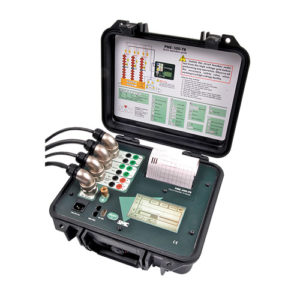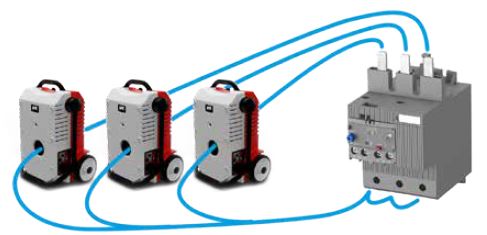How to Test a Circuit Breaker – EuroSMC solutions
The circuit breakers must perform the vital protective function of connecting and disconnecting the electrical power in a reliable way; this requires proving their reliability with on field tests during installation and with regular maintenance tests during its lifetime to prevent costly failures and problems that could even compromising the safety of the substation.
Different circuit breaker test equipment are used to check the operation and condition of circuit breakers on the power systems; How to test a circuit breaker involves many different test techniques and type of testers; there are some initial considerations to properly face how to test a circuit breaker, which leads to different desired functions in the test set; the way of how to test a circuit breaker depends on the type of breaker (MV/HV/LV) and on the feature to be checked to identify potential performance problems (tripping time, synchronism, operating sequences, contact/dynamic resistance, trip curve, protection scheme, motion analysis, etc).
This will define how to test a circuit breaker through different testing tools to be applied to check the equipment under a range of conditions or operation types. Discover how to test a circuit breaker with the different test sets that you can need.
How to test a circuit breaker with several test equipment for the different applications and types of breaker
The circuit breaker test equipment and the different ways of how to test a circuit breaker have the main purpose to reduce to the minimum the maintenance cost, predicting accurately the condition of the breaker with reliable data that justify whether further maintenance is required by opening the breaker or not.
EuroSMC manufactures a complete line of circuit breaker test equipment for different types of tests and applications; how to test a circuit breaker becomes an easier question with the well proved solutions and long EuroSMC experience during the last 30 years.
Anyway, previously to consider how to test a circuit breaker, it is required a deep knowledge of the breaker itself, how it works, its tolerances, and the reference values of previous tests, or the initial values with which to compare the actual results, sometimes defined by a rated timing graph, established settings or initial features given by manufacturer (and proved by the type and routine tests performed at the manufacturer´s facilities); in this sense, how to test a circuit breaker becomes a trending analysis since test results are not always definitive but have meaning just when compared to previous data or results.
How to test a circuit breaker with a circuit breaker analyzer
the timing tests of the different open and close operations of the breaker is an efficient way of how to test a circuit breaker, analyzing not only the trip times but also the essential synchronism of the poles in the different operations. This define how to test a circuit breaker through different simulations of its operation, which can be directly commanded from the circuit breaker analyzer, or initiated by an external signal, checking the opening or closing time of each pole, in single or combined operations (O, C, O-C, C-O, O-C-O, C-O-C), and checking the possible difference between poles or mismatch time which may lead to a dangerous lack of synchronism.
How to test a circuit breaker with a circuit breaker analyzer depends also on the type of possible problems to be confirmed, which leads to check other features such as the possible bouncing, the proper performance of the pre-insertion resistances, the coils condition, and the mechanical analysis through contact travel speed and acceleration data with the use of the appropriate transducers.
 The EuroSMC PME-500-TR is a circuit breaker analyzer that includes all the mentioned functions which can be required for the condition assessment of medium and high voltage circuit breakers; the way of how to test a circuit breaker must also consider the short time that the circuit breaker is out of service, minimizing the setup work, connections, and test complexity; the PME-500-TR is designed with all the foregoing considerations in mind, and also includes the contact resistance measurement of the 3 poles in the same report, saving considerable testing time; it is also equipped with rechargeable batteries, built-in printer, easy to use touch screen, IP67 case, and it is easily transported with just 8 kg and very small size.
The EuroSMC PME-500-TR is a circuit breaker analyzer that includes all the mentioned functions which can be required for the condition assessment of medium and high voltage circuit breakers; the way of how to test a circuit breaker must also consider the short time that the circuit breaker is out of service, minimizing the setup work, connections, and test complexity; the PME-500-TR is designed with all the foregoing considerations in mind, and also includes the contact resistance measurement of the 3 poles in the same report, saving considerable testing time; it is also equipped with rechargeable batteries, built-in printer, easy to use touch screen, IP67 case, and it is easily transported with just 8 kg and very small size.
How to test a circuit breaker with a micro-ohmmeter
The circuit breakers usually carry a large amount of current; higher contact resistance leads to higher losses, lower current carrying capacity and dangerous hot spots in the breaker, so that the resistance testing with micro-ohmmeters are other way of how to test a circuit breaker for detecting and preventing future problems.
 EuroSMC offers different solutions for this application (e.g. PME-500-TR, RAPTOR) but it is needed to highlight the way of how to test a circuit breaker and the contacts condition in inaccessible SF6 or vacuum chambers breakers, which is through the Dynamic Resistance Measurement (DRM); the dynamic resistance test, which is essential in analyzing the wear of the arcing contacts in these breakers, is a function never found before in micro-ohmmeters, but that now is available in the PRIME 600, a micro ohmmeter that integrates both the contact resistance and the dynamic resistance measurement as stand-alone unit.
EuroSMC offers different solutions for this application (e.g. PME-500-TR, RAPTOR) but it is needed to highlight the way of how to test a circuit breaker and the contacts condition in inaccessible SF6 or vacuum chambers breakers, which is through the Dynamic Resistance Measurement (DRM); the dynamic resistance test, which is essential in analyzing the wear of the arcing contacts in these breakers, is a function never found before in micro-ohmmeters, but that now is available in the PRIME 600, a micro ohmmeter that integrates both the contact resistance and the dynamic resistance measurement as stand-alone unit.
How to test a circuit breaker with a micro-ohmeter requires also reliable measurements and a wide injection range with high power that enables for longer test leads, less connections problems, and more accurate measurements. The PRIME is a high current micro ohmmeter up to 600 A of pure DC which also features the higher power on the market. The PRIME also includes the chance to speed the measurement process with a dual ground test method through optional clamp accessory.
How to test a circuit breaker with a high current primary injection tester
the analysis of the tripping time characteristics of LV circuit breakers and molded-case circuit breakers is performed using high current injection, as the way to check the entire functionality. How to test a circuit breaker of this type depends on its maximum rated current, the trip protection settings and the inverse curve types which will define the overload and short-circuit trip pickup levels and time delays; all these features must be checked with the appropriate primary injection test set with the capacity to simulate the corresponding high current faults required and capture the answer of the breaker.

A system which be easily upgraded in power capacity enables how to test a circuit breaker in the different possible situations and range of breakers; how to test a circuit breaker of this type also requires a flexible configuration of the test set to successfully accomplish the specific high current job, and a design that make possible to place it closer to the breaker, and so reducing the power required with shorter test leads; this is the case of the Raptor System, a modular and flexible primary injection system which easily and quickly adapts its power capacity to the several high currents ratings of the different circuit breakers; the Raptor also provides an amazing portability, with the smallest size and weight of the market, and a design which allows for a better test setup.
Since the circuit breakers are part of the protection scheme, checking their behavior in the entire protection circuit is other way of how to test a circuit breaker, analyzing their combined operation with the rest of the elements of the scheme through primary injection testing, for which the multifunctional Raptor System is also very suitable. Similarly, this is also the case of the automatic reclosers, whose whole functionality, including the circuit breaker, is tested through primary injection with the Raptor. The Raptor is the first digital high current injection system, non-variac based, but EuroSMC also offers traditional variac-based equipments, the LET units, with a wide choice of power ranges for circuit breaker testing and primary injection applications.
How to test a circuit breaker with a secondary injection test set
For smaller current requirements, as in the case of miniature circuit breakers, the use of any of the wide range of EuroSMC secondary injection test sets are also other way of how to test a circuit breaker of that type . The PTE-100-C is able to supply up to 250 A for instantaneous trip time tests, and the PTE-50-CET and MENTOR 12 reach up to 150 A, thanks to their source combination capacity. A specific way of how to test a circuit breaker of MCB type in factories and laboratories is the provided by the SMC-12 system, designed to meet the international standards for the routine and quality control tests of MCBs with regards to their thermal and magnetic response.
For more information, please check the related EuroSMC products or contact us.
